The U. P. Trail Read online
Page 4
5
Neale had not been wrong when he told the engineers that once they hada line surveyed across the gorge and faced the steep slopes of the otherside their troubles would be magnified.
They found themselves deeper in the Wyoming hills, a range of mountainsthat had given General Lodge great difficulty upon former exploringtrips, and over which a pass had not yet been discovered.
The old St. Vrain and Laramie Trail wound along the base of these slopesand through the valleys. But that trail was not possible for a railroad.A pass must be found--a pass that would give a grade of ninety feet tothe mile. These mountains had short slopes, and they were high.
It turned out that the line as already surveyed through ravines andacross the gorge had to be abandoned. The line would have to go over thehills. To that end the camp was moved east again to the first slopes ofthe Wyoming hills; from there the engineers began to climb. They reachedthe base of the mountains, where they appeared to be halted for good andall.
The second line, so far as it went, overlooked the Laramie Trail, whichfact was proof that the old trail-finders had as keen eyes as engineers.
With a large band of hostile Sioux watching their movements the engineercorps found it necessary to have the troops close at hand all the time.The surveyors climbed the ridges while the soldiers kept them in sightfrom below. Day after day this futile search for a pass went on. Many ofthe ridges promised well, only to end in impassable cliffs or breaks orascents too steep. There were many slopes and they all looked alike.It took hard riding and hard climbing. The chief and his staff were indespair. Must their great project fail because of a few miles of steepascent? They would not give up.
The vicinity of Cheyenne Pass seemed to offer encouragement. Camp wasmade in the valley on a creek. From here observations were taken. Onemorning the chief, with his subordinates and a scout, ascended the creekand then through the pass to the summit. Again the old St. Vrain andLaramie Trail lay in sight. And again the troops rode along it, with theengineers above.
The chief with his men rode on and up farther than usual; farther thanthey ought to have gone unattended. Once the scout halted and gazedintently across the valley.
"Smoke signals over thar," he said.
The engineers looked long, but none of them saw any smoke. They movedon. But the scout called them back.
"Thet bunch of redskins has split on us. Fust thing we'll run into someof them."
It was Neale's hawk eye that first sighted Indians. "Look! Look!" hecried, in great excitement, as he pointed with shaking finger.
Down a grassy slope of a ridge Indians were riding, evidently to headoff the engineers, to get between them and the troops.
"Wal, we're in fer it now," declared the scout. "We can't get back theway we come up."
The chief gazed coolly at the Indians and then at the long ridge slopingaway from the summit. He had been in tight places before.
"Ride!" was his order.
"Let's fight!" cried Neale.
The band of eight men were well armed and well mounted, and ifimperative, could have held off the Sioux for a time. But General Lodgeand the scout headed across a little valley and up a higher ridge, fromwhich they expected to sight the troops. They rode hard and climbedfast, but it took a quarter of an hour to gain the ridge-top. Sureenough the troops were in sight, but far away, and the Sioux werecutting across to get in front.
It was a time for quick judgment. The scout said they could not ridedown over the ridge, and the chief decided they must follow along it.The going got to be hard and rough. One by one the men dismounted tolead their horses. Neale, who rode a mettlesome bay, could scarcely keepup.
"Take mine," called Larry King, as he turned to Neale.
"Red, I'll handle this stupid beast or--"
"Wal, you ain't handlin' him," interrupted King. "Hosses is my job, youknow."
Red took the bridle from Neale and in one moment the balky horserecognized a master arm.
"By Heaven! we've got to hurry!" called Neale.
It did seem that the Indians would head them off. Neale and King laboredover the rocky ground as best they could, and by dint of hard effortcame up with their party. The Indians were quartering the other ridge,riding as if on level ground. The going grew rougher. Baxter's horseslipped and lamed his right fore leg. Henney's saddle turned, and morevaluable time was lost. All the men drew their rifles. At every dipof ground they expected to come to a break that would make a standinevitable.
From one point on the ridge they had a good view of the troops.
"Signal!" ordered the chief.
They yelled and shot and waved hats and scarfs. No use--the soldierskept moving on at a snail pace far below.
"On--down the ridge!" was the order.
"Wal, General, thet looks bad to me," objected the scout. Red Kingshoved his lean, brown hand between them. There was a flame in hisflashing, blue glance as it swept the slowly descending ridge.
"Judgin' the lay of land is my job," he said, in his cool way. "We'llgit down heah or not at all."
Neale was sore, lame, and angry as well. He kept gazing across at theSioux. "Let's stop--and fight," he panted. "We can--whip--that bunch."
"We may have to fight, but not yet," replied the chief. "Come on."
They scrambled on over rocky places, up and down steep banks. Here andthere were stretches where it was possible to ride, and over these theymade better time. The Indians fell out of sight under the side of theridge, and this fact was disquieting, for no one could tell how soonthey would show up again or in what quarter. This spurred the men tosterner efforts.
Meanwhile the sun was setting and the predicament of the engineers grewmore serious. A shout from Neale, who held up the rear, warned allthat the Indians had scaled the ridge behind them and now were instraightaway pursuit. Thereupon General Lodge ordered his men to faceabout with rifles ready. This move checked the Sioux. They halted out ofrange.
"They're waitin' fer dark to set in," said the scout.
"Come on! We'll get away yet," said the chief, grimly. They went on, anddarkness began to fall about them. This increased both the difficultyand the danger. On the other hand, it enabled them to try and signal thetroops with fire. One of them would hurry ahead and build a fire whilethe others held back to check the Indians if they appeared. And atlength their signals were answered by the troops. Thus encouraged, thelittle band of desperate men plunged on down the slope. And just whennight set in black--the fateful hour that would have precipitated theIndian attack--the troops met the engineers on the slope. The Indiansfaded away into the gloom without firing a shot. There was a generalrejoicing. Neale, however, complained that he would rather have foughtthem.
"Wal, I shore was achin' fer trouble," drawled his faithful ally, King.
The flagman, Casey, removed his black pipe to remark, "All thet cloimbwithout a foight."
General Lodge's first word to Colonel Dillon was evidently inspired byCasey's remark.
"Colonel, did you have steep work getting up to us?"
"Yes, indeed, straight up out of the valley," was the rejoinder.
But General Lodge did not go back to camp by this short cut down thevalley. He kept along the ridge, and it led for miles slowly down to theplain. There in the starlight he faced his assistants with singular fireand earnestness.
"Men, we've had a bad scare and a hard jaunt, but we've found our passover the Wyoming hills. To-morrow we'll run a line up that long ridge.We'll name it Sherman Pass.... Thanks to those red devils!"
On the following morning Neale was awakened from a heavy, dreamlesssleep by a hard dig in the ribs.
"Neale--air you daid?" Larry was saying. "Wake up! An' listen to thet."
Neale heard the clear, ringing notes of a bugle-call. He rolled out ofhis blankets. "What's up, Red?" he cried, reaching for his boots.
"Wal, I reckon them Injuns," drawled Red.
It was just daylight. They found the camp astir--troopers running forhorse
s, saddles, guns.
"Red, you get our horses and I'll see what's up," cried Neale.
The cowboy strode off, hitching at his belt. Neale ran forward intocamp. He encountered Lieutenant Leslie, whom he knew well, and who toldhim a scout had come in with news of a threatened raid; Colonel Dillonhad ordered out a detachment of troopers.
"I'm going," shouted Neale. "Where's that scout?"
Neale soon descried a buckskin-clad figure, and he made toward it. Theman, evidently a trapper or hunter, carried a long, brown rifle, and hehad a powder-horn and bullet-pouch slung over his shoulder. There was aknife in his belt. Neale went directly up to the man.
"My name's Neale," he said. "Can I be of any help?"
He encountered a pair of penetrating gray eyes.
"My name's Slingerland," replied the other, as he offered his hand. "Areyou an officer?"
"No. I'm a surveyor. But I can ride and shoot. I've a cowboy with me--aTexan. He'll go. What's happened?"
"Wal, I ain't sure yet. But I fear the wust. I got wind of some Siouxthet was trailin' some prairie-schooners up in the hills. I warned theboss--told him to break camp an' run. Then I come fer the troops. Butthe troops had changed camp an' I jest found them. Reckon we'll be toolate."
"Was it a caravan?" inquired Neale, intensely interested.
"Six wagons. Only a few men. Two wimmen. An' one girl."
"Girl!" exclaimed Neale.
"Yes. I reckon she was about sixteen. A pretty girl with big, soft eyes.I offered to take her up behind me on my hoss. An' they all wanted herto come. But she wouldn't.... I hate to think--"
Slingerland did not finish his thought aloud. Just then Larry rode up,leading Neale's horse. Slingerland eyed the lithe cowboy.
"Howdy!" drawled Larry. He did not seem curious or eager, and his cool,easy, reckless air was in sharp contrast to Neale's fiery daring.
"Red, you got the rifles, I see," said Neale.
"Sure, an' I rustled some biscuits."
In a few moments the troops were mounted and ready. Slingerland led themup the valley at a rapid trot and soon started to climb. When he reachedthe top he worked up for a mile, and then, crossing over, went downinto another valley. Up and down he led, over ridge after ridge, until apoint was reached where the St. Vrain and Laramie Trail could be seen inthe valley below. From there he led them along the top of the ridge, andjust as the sun rose over the hills he pointed down to a spot where thecaravan had been encamped. They descended into this valley. There in thetrail were fresh tracks of unshod horses.
"We ain't fur behind, but I reckon fur enough to be too late," saidSlingerland. And he clenched a big fist.
On this level trail he led at a gallop, with the troops behind in theclattering roar. They made short work of that valley. Then rougherground hindered speedy advance.
Presently Slingerland sighted something that made him start. It provedto be the charred skeleton of a prairie-schooner. The oxen were nowhereto be seen.
Then they saw that a little beyond blankets and camp utensils litteredthe trail. Still farther on the broad wheel-tracks sheered off the road,where the hurried drivers had missed the way in the dark. This was open,undulating ground, rock-strewn and overgrown with brush. A ledge ofrock, a few scraggy trees, and more black, charred remains of wagonsmarked the final scene of the massacre.

 The Heritage of the Desert: A Novel
The Heritage of the Desert: A Novel To the Last Man
To the Last Man Desert Gold
Desert Gold The Spirit of the Border: A Romance of the Early Settlers in the Ohio Valley
The Spirit of the Border: A Romance of the Early Settlers in the Ohio Valley The U. P. Trail
The U. P. Trail The Rustlers of Pecos County
The Rustlers of Pecos County The Border Legion
The Border Legion The Young Forester
The Young Forester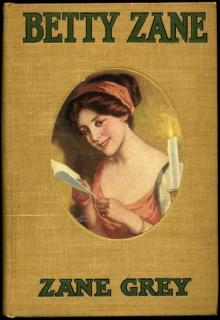 Betty Zane
Betty Zane Riders of the Purple Sage
Riders of the Purple Sage The Second Zane Grey MEGAPACK®
The Second Zane Grey MEGAPACK® The Rainbow Trail
The Rainbow Trail The Man of the Forest
The Man of the Forest The Mysterious Rider
The Mysterious Rider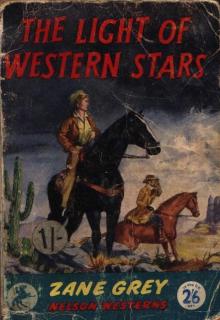 The Light of the Western Stars
The Light of the Western Stars The Last of the Plainsmen
The Last of the Plainsmen Collected Works of Zane Grey
Collected Works of Zane Grey The Call of the Canyon
The Call of the Canyon Twin Sombreros
Twin Sombreros The Dude Ranger
The Dude Ranger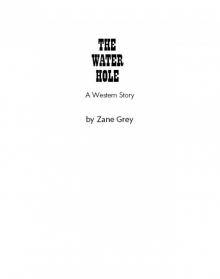 The Water Hole
The Water Hole Raiders of Spanish Peaks
Raiders of Spanish Peaks West of the Pecos
West of the Pecos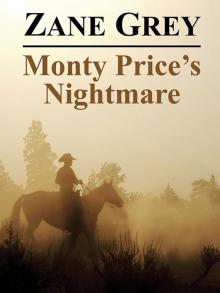 Monty Price's Nightmare
Monty Price's Nightmare Stairs of Sand
Stairs of Sand Rogue River Feud
Rogue River Feud Union Pacific
Union Pacific The Western Romance MEGAPACK ®: 20 Classic Tales
The Western Romance MEGAPACK ®: 20 Classic Tales The Lone Star Ranger
The Lone Star Ranger The Zane Grey Megapack
The Zane Grey Megapack Shadow on the Trail
Shadow on the Trail The Vanishing American
The Vanishing American The Trail Driver
The Trail Driver War Comes to the Big Bend
War Comes to the Big Bend The Westerners
The Westerners Silvermane
Silvermane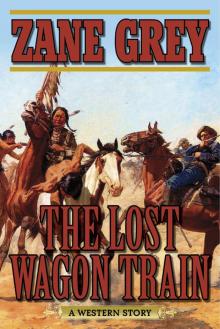 The Lost Wagon Train
The Lost Wagon Train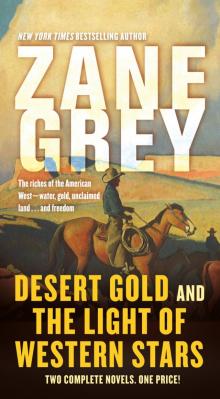 Desert Gold and the Light of Western Stars
Desert Gold and the Light of Western Stars Wildfire and the Heritage of the Desert
Wildfire and the Heritage of the Desert The Great Trek
The Great Trek Cabin Gulch
Cabin Gulch Code of the West
Code of the West Sunset Pass
Sunset Pass Panguitch
Panguitch The Drift Fence
The Drift Fence Dorn Of The Mountains
Dorn Of The Mountains Desert Heritage
Desert Heritage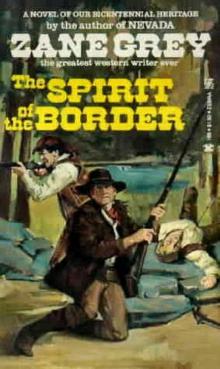 The Spirit Of The Border
The Spirit Of The Border Buffalo Stampede
Buffalo Stampede The Hash Knife Outfit
The Hash Knife Outfit The Lone Star Ranger and the Mysterious Rider
The Lone Star Ranger and the Mysterious Rider The Shepherd of Guadaloupe
The Shepherd of Guadaloupe Riders of the Purple Sage (Leisure Historical Fiction)
Riders of the Purple Sage (Leisure Historical Fiction) Thunder Mountain
Thunder Mountain The Spirit of the Border and the Last Trail
The Spirit of the Border and the Last Trail The Day of the Beast
The Day of the Beast The Heritage of the Desert
The Heritage of the Desert The Deer Stalker
The Deer Stalker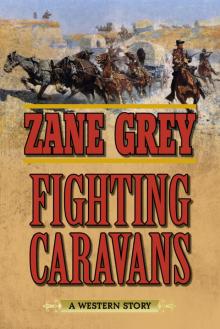 Fighting Caravans
Fighting Caravans